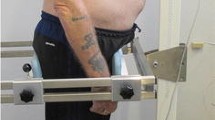Abstract
Background
The decrease in recurrence rates in ventral hernia surgery have led to a redirection of focus towards other important patient-related endpoints. One such endpoint is abdominal wall function. The aim of the present study was to evaluate the reliability and external validity of abdominal wall strength measurement using the Biodex System-4 with a back abdomen unit.
Material and method
Ten healthy volunteers and ten patients with ventral hernias exceeding 10 cm were recruited. Test–retest reliability, both with and without girdle, was evaluated by comparison of measurements at two test occasions 1 week apart. Reliability was calculated by the interclass correlation coefficients (ICC) method. Validity was evaluated by correlation with the well-established International Physical Activity Questionnaire (IPAQ) and a self-assessment of abdominal wall strength.
Results
One person in the healthy group was excluded after the first test due to neck problems following minor trauma. The reliability was excellent (>0.75), with ICC values between 0.92 and 0.97 for the different modalities tested. No differences were seen between testing with and without a girdle. Validity was also excellent both when calculated as correlation to self-assessment of abdominal wall strength, and to IPAQ, giving Kendall tau values of 0.51 and 0.47, respectively, and corresponding P values of 0.002 and 0.004.
Conclusion
Measurement of abdominal muscle function using the Biodex System-4 is a reliable and valid method to assess this important patient-related endpoint. Further investigations will be made to explore the potential of this technique in the evaluation of the results of ventral hernia surgery, and to compare muscle function after different abdominal wall reconstruction techniques.


Similar content being viewed by others
References
Langer C, Schaper A, Liersch T, Kulle B, Flosman M (2005) Prognosis factors in incisional hernia surgery: 25 years of experience. Hernia 9:16–21
Millbourn D, Cengiz Y, Israelsson LA (2009) Effect of stitch length on wound complications after closure of midline incisions: a randomized controlled trial. Arch Surg 144:1056–1059
Pless TK, Pless JE (1993) Giant ventral hernias and their repair. A 10 year follow up study. Scand J Plast Reconstr Surg Hand Surg 27:311–315
Burger JW, Luijendijk RW, Hop WC, Halm JA, Verdaasdonk EG, Jeekel J (2004) Long-term follow-up of a randomized controlled trial of suture versus mesh repair of incisional hernia. Ann Surg 240:578–583
Feiring DC, Ellenbecker TS, Derscheid GL (1990) Test–retest reliability of the biodex isokinetic dynamometer. J Sports Phys Ther 11:298–300
Meeteren J, Roebroeck M, Stam H (2002) Test–retest reliability in isokinetic muscle strength measurements of the shoulder. J Rehabil Med 34:91–95
Holmbäck AM, Porter MM, Downham D, Lexell J (1999) Reliability of isokinetic ankle dorsalflexor strength measurements in healthy young men and women. Scand J Med 31:229–239
Saenz A, Avellanet M, Hijos E, Chaler J, Garreta R, Pujol E, Sandoval B, Buen C, Farreny A (2010) Knee isokinetic test–retest: a multicentre knee isokinetic test–retest study of a fatigue protocol. Eur J Phys Rehabil Med 46:81–88
Craig CL, Marshall AL, Sjöström M, Bauman AE, Booth ML, Ainsworth BE, Pratt M, Ekelund U, Yngve A, Sallis JF, Oja P (2003) International physical activity questionnaire: 12-country reliability and validity. Med Sci Sports Exerc 35:1381–1395
Bressel E, Willardson JM, Thompson B, Fontana FE (2009) Effect of instruction, surface stability, and load intensity on trunk muscle activity. J Electromyogr Kinesiol 19:500–504 Epub ahead of print
Ekelund U, Sepp H, Brage S, Becker W, Jakes R, Hennings M, Wareham NJ (2006) Criterion-related validity of the last 7-day, short form of the international physical activity questionnaire in Swedish adults. Public Health Nutr 9:258–265
McGraw KO, Wong SP (1996) Forming inferences about some interclass correlation coefficients. Psychol Methods 1:30–46
Fränneby U, Sandblom G, Nordin P, Nyrén O, Gunnarsson U (2006) Risk factors for long-term pain after hernia surgery. Ann Surg 244:212–219
Fränneby U, Sandblom G, Andersson M, Heuman R, Nordin P, Nyrén O, Gunnarsson U (2008) Validation of a inguinal pain questionnaire; a new instrument for evaluation of chronic pain after operative treatment of inguinal hernia. Br J Surg 95:488–493
Wilson KG, Graham ID, Viola RA, Chater S, de Faye BJ, Weaver LA, Lachance JA (2004) Structured interview assessment of symptoms and concerns in palliative care. Can J Psychiatr 49:350–358
Coll AM, Ameen JR, Mead D (2004) Postoperative pain assessment tools in day surgery: literature review. J Adv Nurs 46:124–133 Review
Author information
Authors and Affiliations
Corresponding author
Rights and permissions
About this article
Cite this article
Gunnarsson, U., Johansson, M. & Strigård, K. Assessment of abdominal muscle function using the Biodex System-4. Validity and reliability in healthy volunteers and patients with giant ventral hernia. Hernia 15, 417–421 (2011). https://doi.org/10.1007/s10029-011-0805-1
Received:
Accepted:
Published:
Issue Date:
DOI: https://doi.org/10.1007/s10029-011-0805-1




